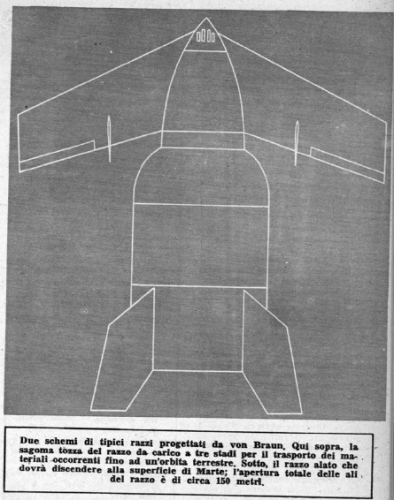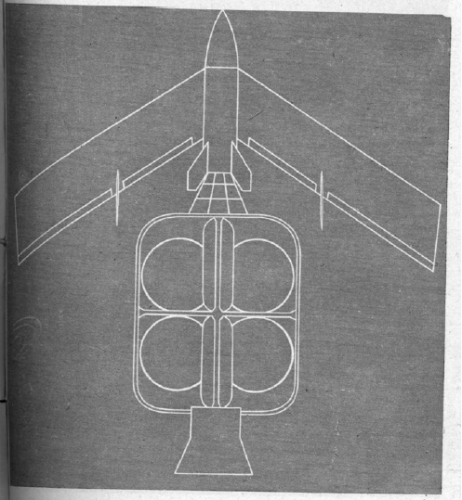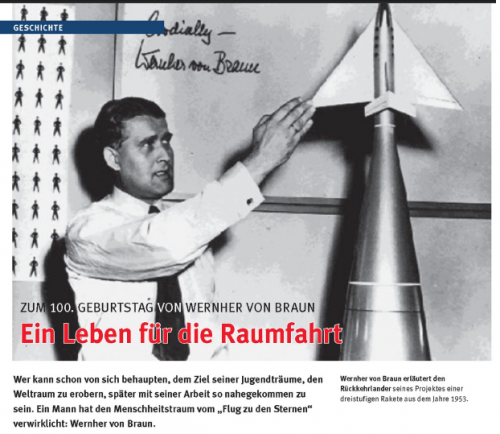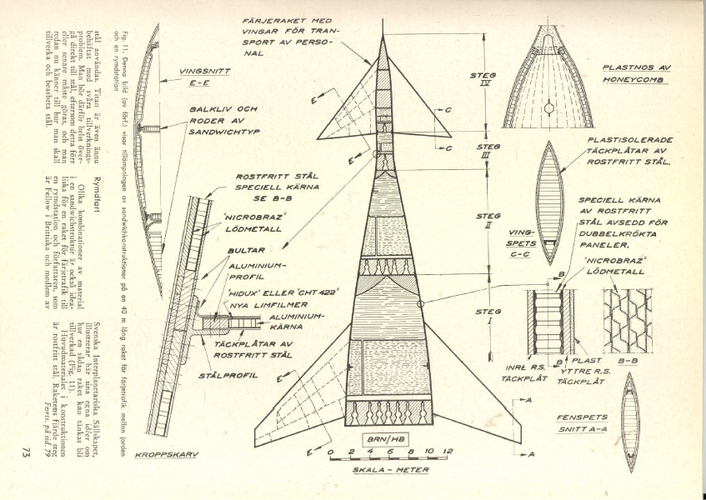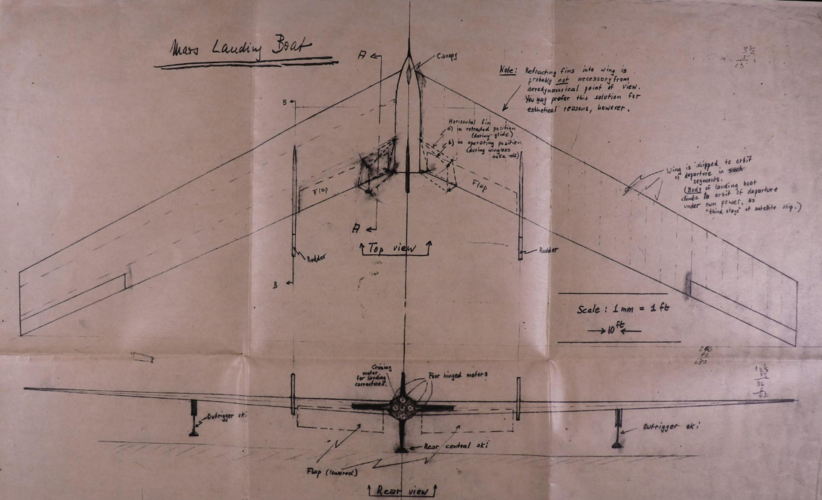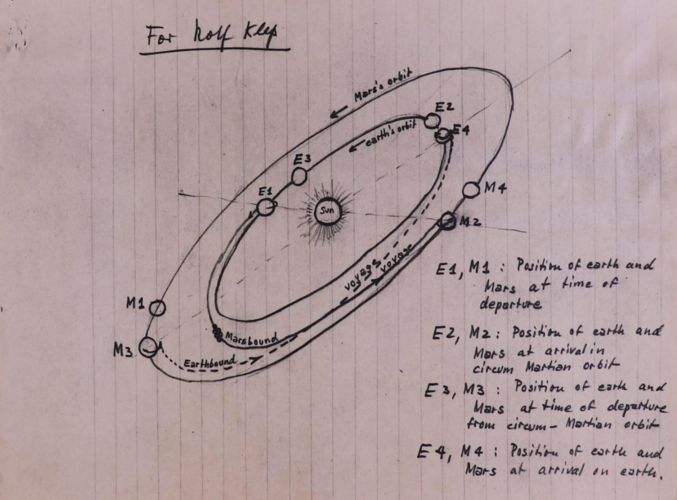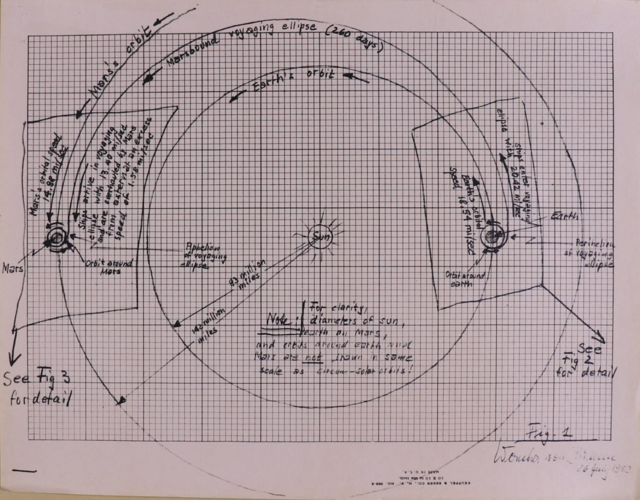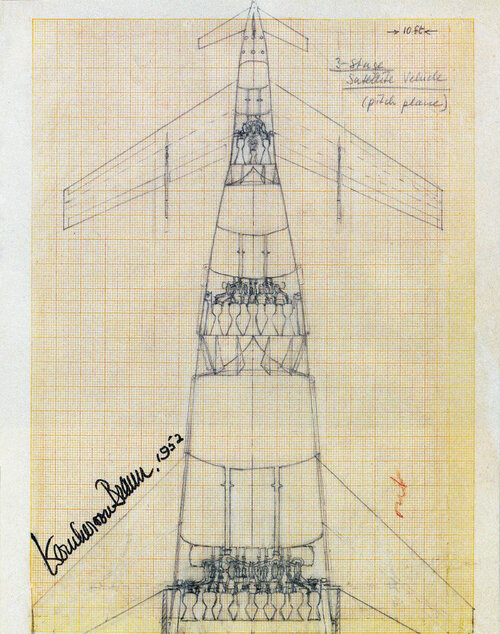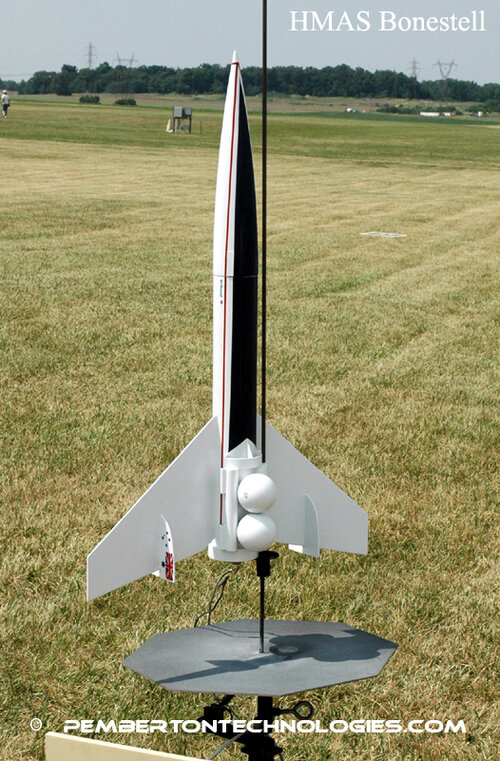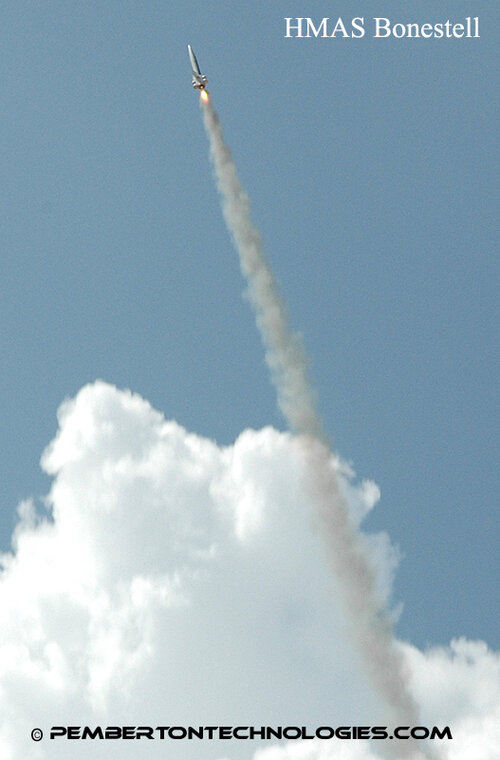You are using an out of date browser. It may not display this or other websites correctly.
You should upgrade or use an alternative browser.
You should upgrade or use an alternative browser.
Von Braun's Ferry Rocket of 1952
- Thread starter archipeppe
- Start date
antigravite
ACCESS: Top Secret
- Joined
- 25 April 2008
- Messages
- 836
- Reaction score
- 258
Triton said:Von Braun Ferry Rocket.
Hi, this might not be the best thread but let's see…
In this post referenced above, there is a cycle / donut shaped space station which was, among many others, "recycled" by Kubrick. (Pun intended.) Does anyone have an idea of where this toroidal - wheel - donut shape space station comes from. This is both a history and a design question. Did this design originate from BIS' R.A.E. Smith? Tsiolkovsky? Perelman? from the very brainchild of von Braun? From earlier fiction, such as 1930s era pulps? Could even be Flash Gorden (strongly doubt that). Disney?
Where does this donut space station shape come from? Who was the seed? An engineer? An illustrator whose work would be fushed further in the realm of engineering? Was it Bonestell's own ideas?
A.
- Joined
- 18 March 2013
- Messages
- 1,228
- Reaction score
- 4,045
The BIS had the ealiest 'refined' version of the 'wheel' type space-station I know of. I believe von Braun had presented a wheel before the war which was later fleshed out and popularized in the Viking press books. Disney was late to the party with their version, late 50's.
The von Braun concept became the foundation for other interpretations of the wheel type space station. This model representing the concept from the movie, The Conquest Of Space, for example.

David
The von Braun concept became the foundation for other interpretations of the wheel type space station. This model representing the concept from the movie, The Conquest Of Space, for example.
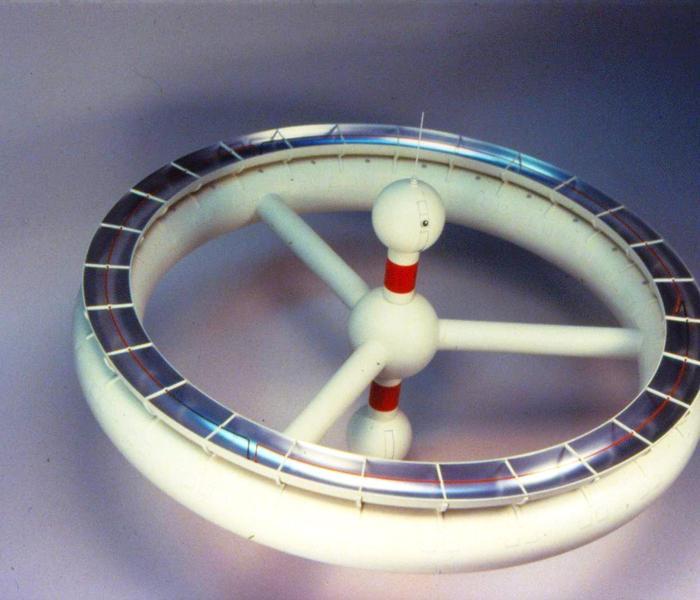
David
martinbayer
ACCESS: Top Secret
- Joined
- 6 January 2009
- Messages
- 3,402
- Reaction score
- 3,911
The first concrete conceptual design of a wheel space station seems to go back to Herman Potočnik (a.k.a. Hermann Noordung) in the late nineteen twenties, see https://www.bis-space.com/what-we-do/projects/bis-space-station and https://en.wikipedia.org/wiki/Rotating_wheel_space_station.
The Germans certainly understood aerodynamic heating. When V-2s exploded after launch, this problem was solved by adding 'glass wool' insulation. The wings in the upper part of the rocket as shown were not practical.
- Joined
- 9 October 2009
- Messages
- 21,979
- Reaction score
- 13,647
This model representing the concept from the movie, The Conquest Of Space, for example
Some of the space-station props from The Conquest of Space reappear in the 1959 TV pilot Destination Space.
- Joined
- 16 April 2008
- Messages
- 9,616
- Reaction score
- 14,526
It is frustrating to think where we might be now if Von Braun had been given the budget to seriously pursue his initial plan for space development.
There's no guarantee this would have actually worked, though. There was a lot that was not correctly understood about thermal heating on reentry, for example. And that glider is a huge amount of parasitic mass that isn't delivering actual payload to orbit (the Shuttle problem, but with less sophisticated technology).
Astronautix did some analysis of the Ferry Rocket and it's not great...
topspeed3
ACCESS: Secret
- Joined
- 31 January 2011
- Messages
- 329
- Reaction score
- 116
Thanks all for your kind comments!!
Justo Miranda said:I am curious about the presence of the thermal protection tiles in the nosecone. Do you have additional information on this?
Yep, there was clearly visible in the Collier's cover of 14 March 1953 made by Fred Freeman.
To answer to Michel I think that this amazing design was still too much "plane" and even less "spacecraft".
Too much drag due to the huge wing span and a real nightmare for re-entry thermal control.
The 1956 design (Disney's Men in Space), conceived mostly by Willy Ley, was more practical indeed it was still too much linked to F102/106 fighters design.
Anyway my next presentation on this matter (I will do by since two languages version, both Italian and English, so you will do not have any problem in understanding it) will be the 1956 design.
Are you absolutely sure. It makes von Brown an idiot ?
- Joined
- 18 March 2013
- Messages
- 1,228
- Reaction score
- 4,045
Thanks all for your kind comments!!
Justo Miranda said:I am curious about the presence of the thermal protection tiles in the nosecone. Do you have additional information on this?
Yep, there was clearly visible in the Collier's cover of 14 March 1953 made by Fred Freeman.
To answer to Michel I think that this amazing design was still too much "plane" and even less "spacecraft".
Too much drag due to the huge wing span and a real nightmare for re-entry thermal control.
The 1956 design (Disney's Men in Space), conceived mostly by Willy Ley, was more practical indeed it was still too much linked to F102/106 fighters design.
Anyway my next presentation on this matter (I will do by since two languages version, both Italian and English, so you will do not have any problem in understanding it) will be the 1956 design.
Are you absolutely sure. It makes von Brown an idiot ?
As to the reentry survivability of the von Braun canard: At the time of the proposal (mid to late 40's) I suggest that the Sangar 'atmospheric skipping' method of bleeding off the vehicle kinetic energy -- which subjected the vehicle to many brief periods of 'low' thermal loading and structural stress -- was, at the time (and still is), a viable means of getting a low wing loaded vehicle out of orbital velocity and into the sensible atmosphere in one piece.
We have become accustomed to the one-shot ballistic plunge of reentry vehicles -- and that includes the brick-with-wings, Space Shuttle. Distribute the total heat-load over time, in a series of skips, and all of a sudden Freeman's thermal plates have merrit.
- Joined
- 13 August 2007
- Messages
- 8,464
- Reaction score
- 11,066
There's no guarantee this would have actually worked, though. There was a lot that was not correctly understood about thermal heating on reentry, for example. And that glider is a huge amount of parasitic mass that isn't delivering actual payload to orbit (the Shuttle problem, but with less sophisticated technology).
his overworked version of 1955 has quite different layout, the Orbiter has smaller Delta wings
if they had build the system it would again be very different of original plan:
like Kero/lox engines and Orbiter would look like enlarge Dyna-soar
archipeppe
ACCESS: Top Secret
- Joined
- 18 October 2007
- Messages
- 2,433
- Reaction score
- 3,160
I Never said that von Braun was an idiot.
Frankly, I don't would someone put in my mounth such bullxxxt.
The point is that even von Braun, when designed his booster for Collier's (like anyone else at that times) had a limitated knowledge about re-entry thermodynamics.
Only during mid-50's it was clearer what happened during a re-entry, essentially because there was the need about the nuclear devices onboard the first generation of ICBMs.
Is not a coincidence that the same von Braun refined his design not only once but twice during the decade.
Frankly, I don't would someone put in my mounth such bullxxxt.
The point is that even von Braun, when designed his booster for Collier's (like anyone else at that times) had a limitated knowledge about re-entry thermodynamics.
Only during mid-50's it was clearer what happened during a re-entry, essentially because there was the need about the nuclear devices onboard the first generation of ICBMs.
Is not a coincidence that the same von Braun refined his design not only once but twice during the decade.
It is important to note what happened during the war and what was published after. The Sänger space plane was fully worked out. An attempt was made to add short wings to the V-2 during the war. The Russians could not be shown practical designs. They had to have some flaw, otherwise they would copy good ideas. The Disney company was part of the American propaganda system during the war and after. Von Braun was no idiot but advanced ideas could not be shown. And von Braun and his associates were under the control of US intelligence and were in direct competition with American companies when it came to rocket design, and advanced aircraft designs. Things would definitely had gone differently if the Germans had been allowed to build rockets of their own design but it was important to show the Russians that 'our Germans' were not competent.
I Never said that von Braun was an idiot.
Frankly, I don't would someone put in my mounth such bullxxxt.
The point is that even von Braun, when designed his booster for Collier's (like anyone else at that times) had a limitated knowledge about re-entry thermodynamics.
Only during mid-50's it was clearer what happened during a re-entry, essentially because there was the need about the nuclear devices onboard the first generation of ICBMs.
Is not a coincidence that the same von Braun refined his design not only once but twice during the decade.
Can you provide a reference that shows how knowledge of re-entry conditions was obtained by the mid-1950s?
There's no guarantee this would have actually worked, though. There was a lot that was not correctly understood about thermal heating on reentry, for example. And that glider is a huge amount of parasitic mass that isn't delivering actual payload to orbit (the Shuttle problem, but with less sophisticated technology).
Astronautix did some analysis of the Ferry Rocket and it's not great...
Of course. The designs show only a concept rather than an engineering solution which would have come after the necessary testing. The main thing is to have started much earlier than we did and along the step by step path of building up orbital infrastructure before heading out to the moon. Von Braun would also have probably gone the route of orbital re-fuelling rather than a single giant rocket to lift everything at once.
Can you provide a reference that shows how knowledge of re-entry conditions was obtained by the mid-1950s?
Extensive research on blunt-body aerodynamics was underway in the early 1950s. Google the works of H. Julian Allen and Al Eggers, for starters. For example:
Thank you. The report in the link shows that as early as August 25, 1953, it was known that aside from blunt body heating problems, the addition of fins would add heating problems that would complicate materials selection. It was not advisable. But the public and the Russians needed to be shown a design with wings or a delta.
- Joined
- 3 June 2011
- Messages
- 18,348
- Reaction score
- 12,266
Can you provide a reference that shows how knowledge of re-entry conditions was obtained by the mid-1950s?
Extensive research on blunt-body aerodynamics was underway in the early 1950s. Google the works of H. Julian Allen and Al Eggers, for starters. For example:
Thank you. The report in the link shows that as early as August 25, 1953, it was known that aside from blunt body heating problems, the addition of fins would add heating problems that would complicate materials selection. It was not advisable. But the public and the Russians needed to be shown a design with wings or a delta.
Might also want to read up on the X-17.
- Joined
- 13 August 2007
- Messages
- 8,464
- Reaction score
- 11,066
Can you provide a reference that shows how knowledge of re-entry conditions was obtained by the mid-1950s?
In 1952 there was almost no data on Issue reentry on Hypersonic speed, allot engineers like von Braun and Sänger believed a Large wing do trick.
but that change in next 3 years,
there was allot of studies and Testing done for ICBM Warheads in mid 1950s, for Redstone, Jupiter, Thor, Atlas and Titan I
like the G.E. Mk 2 "heat sink" and AVCO Mk 4 "ablative material" reentry vehicle,
but those were ultra top-secret project and von Braun is not a idiot bragging about those hardware as heat shield for his Ferry on TV !
also not on Aerodyamics of hypersonic gliders under study of BOMI or ROBO, what became Dyna Soar...
Are you absolutely sure. It makes von Brown an idiot ?
No, it makes him wrong. The Wright Brothers were not idiots for not designing their airplanes to have radar and jet engines; they were simply too early. Similarly, in 1952 von Braun did not have access to data that the fifties would later produce showing just how horrifying re-entry heating can be on sharp leading edges.
As to the reentry survivability of the von Braun canard: At the time of the proposal (mid to late 40's) I suggest that the Sangar 'atmospheric skipping' method of bleeding off the vehicle kinetic energy -- which subjected the vehicle to many brief periods of 'low' thermal loading and structural stress -- was, at the time (and still is), a viable means of getting a low wing loaded vehicle out of orbital velocity and into the sensible atmosphere in one piece.
Not so much. What happens when you do that is that you heat-soak the craft over a longer stretch, and at lower max levels... and this is in general *worse* for your craft. Attend:
1: If you just say "ᚠᚪᛣᚳ ᛁᛏ!" and power dive into the atmosphere like a meteor, yes, you'll get damn hot. But you'll build up an incandescent plasma sheath around the hottest bits; and while the radiant energy from the plasma will do the underlying structure no good, the plasma, being incandescent, is *opaque* to most radiation. Thus that hot blanket of horribleness will protect your from even *more* thermal horribleness.
2: If you come in fast, there is insufficient time for the heat to propagate through your vehicle structure. The outer layers will be cooked, but not the internal structure. So if you have an ablative heat shield or a fluid evaporative system, the super-heated bits will be simply *gone* and your craft will not be all that warm.
But if you dilly-dally with skipping, you spend far longer dumping heat into your craft at a slower rate... without so much of the protection that insane speed provides. The Dyna Soar began life with this, and as a result the cockpit was surrounded by a water-wall to keep the astronaut from being cooked in his own juices because the *entire* interior of the craft, except for the cockpit and electronics moduels, both of which would be actively cooled, would be white hot.
topspeed3
ACCESS: Secret
- Joined
- 31 January 2011
- Messages
- 329
- Reaction score
- 116
Can you provide a reference that shows how knowledge of re-entry conditions was obtained by the mid-1950s?
Extensive research on blunt-body aerodynamics was underway in the early 1950s. Google the works of H. Julian Allen and Al Eggers, for starters. For example:
Thank you. The report in the link shows that as early as August 25, 1953, it was known that aside from blunt body heating problems, the addition of fins would add heating problems that would complicate materials selection. It was not advisable. But the public and the Russians needed to be shown a design with wings or a delta.
Germans had M4 capable wind tunnels already in during wartime. They certainly knew heating.
topspeed3
ACCESS: Secret
- Joined
- 31 January 2011
- Messages
- 329
- Reaction score
- 116
Are you absolutely sure. It makes von Brown an idiot ?
No, it makes him wrong. The Wright Brothers were not idiots for not designing their airplanes to have radar and jet engines; they were simply too early. Similarly, in 1952 von Braun did not have access to data that the fifties would later produce showing just how horrifying re-entry heating can be on sharp leading edges.
Possibly, but check out the wing loading of the re-entry canard especially for Mars mission...and compare it to the space shuttle.
Can you provide a reference that shows how knowledge of re-entry conditions was obtained by the mid-1950s?
Extensive research on blunt-body aerodynamics was underway in the early 1950s. Google the works of H. Julian Allen and Al Eggers, for starters. For example:
Thank you. The report in the link shows that as early as August 25, 1953, it was known that aside from blunt body heating problems, the addition of fins would add heating problems that would complicate materials selection. It was not advisable. But the public and the Russians needed to be shown a design with wings or a delta.
Germans had M4 capable wind tunnels already in during wartime. They certainly knew heating.
They did. The US captured a Mach 4.4 wind tunnel. When V-2s exploded in flight, 'glass wool' insulation was added. An attempt to add short, swept back wings to enable the V-2 to glide was not fully worked out.
topspeed3
ACCESS: Secret
- Joined
- 31 January 2011
- Messages
- 329
- Reaction score
- 116
Can you provide a reference that shows how knowledge of re-entry conditions was obtained by the mid-1950s?
Extensive research on blunt-body aerodynamics was underway in the early 1950s. Google the works of H. Julian Allen and Al Eggers, for starters. For example:
Thank you. The report in the link shows that as early as August 25, 1953, it was known that aside from blunt body heating problems, the addition of fins would add heating problems that would complicate materials selection. It was not advisable. But the public and the Russians needed to be shown a design with wings or a delta.
Germans had M4 capable wind tunnels already in during wartime. They certainly knew heating.
They did. The US captured a Mach 4.4 wind tunnel. When V-2s exploded in flight, 'glass wool' insulation was added. An attempt to add short, swept back wings to enable the V-2 to glide was not fully worked out.
Yes, but von Braun was not making a V-1 nor V-2...but a re-entry capable vehicle.
There is air density up to 5 000 km altitude.
Shuttle started to react to controls a 110 km altitude...and started heating an 30 - 80 km altitude.
Can you provide a reference that shows how knowledge of re-entry conditions was obtained by the mid-1950s?
Extensive research on blunt-body aerodynamics was underway in the early 1950s. Google the works of H. Julian Allen and Al Eggers, for starters. For example:
Thank you. The report in the link shows that as early as August 25, 1953, it was known that aside from blunt body heating problems, the addition of fins would add heating problems that would complicate materials selection. It was not advisable. But the public and the Russians needed to be shown a design with wings or a delta.
Germans had M4 capable wind tunnels already in during wartime. They certainly knew heating.
They did. The US captured a Mach 4.4 wind tunnel. When V-2s exploded in flight, 'glass wool' insulation was added. An attempt to add short, swept back wings to enable the V-2 to glide was not fully worked out.
Yes, but von Braun was not making a V-1 nor V-2...but a re-entry capable vehicle.
There is air density up to 5 000 km altitude.
Shuttle started to react to controls a 110 km altitude...and started heating an 30 - 80 km altitude.
Perhaps you can explain how heating was determined for the Saenger space plane. How materials selection was determined. How atmospheric skipping was determined. Not to mention booster requirements. I am aware of air density.
topspeed3
ACCESS: Secret
- Joined
- 31 January 2011
- Messages
- 329
- Reaction score
- 116
Can you provide a reference that shows how knowledge of re-entry conditions was obtained by the mid-1950s?
Extensive research on blunt-body aerodynamics was underway in the early 1950s. Google the works of H. Julian Allen and Al Eggers, for starters. For example:
Thank you. The report in the link shows that as early as August 25, 1953, it was known that aside from blunt body heating problems, the addition of fins would add heating problems that would complicate materials selection. It was not advisable. But the public and the Russians needed to be shown a design with wings or a delta.
Germans had M4 capable wind tunnels already in during wartime. They certainly knew heating.
They did. The US captured a Mach 4.4 wind tunnel. When V-2s exploded in flight, 'glass wool' insulation was added. An attempt to add short, swept back wings to enable the V-2 to glide was not fully worked out.
Yes, but von Braun was not making a V-1 nor V-2...but a re-entry capable vehicle.
There is air density up to 5 000 km altitude.
Shuttle started to react to controls a 110 km altitude...and started heating an 30 - 80 km altitude.
Perhaps you can explain how heating was determined for the Saenger space plane. How materials selection was determined. How atmospheric skipping was determined. Not to mention booster requirements. I am aware of air density.
I recall Sänger was to skip at 30 km altitude...which was considered space by standards of the time. Von Braun canards were to be flown into real space above Karman line which is 100 km.
I have no idea how Sänger would have arranged his system. By the looks of it I assume it would have burned. Re-generative cooling was at least in the engines.
Von Braun was asked to promote fiction. The Russians could not be shown practical designs. Photos exist of at least one V-2 with short, swept back wings. Von Braun knew what would happen with a rocket travelling faster. The Saenger space plane and its designer, obviously had upper atmosphere data. They obviously knew what booster arrangement was required, the total weight of the vehicle and fuel. There is at least one photo of the engine that was to be used being test fired. There is at least one photo of a wind tunnel model. The Americans captured a document that showed the flight path of this vehicle over the earth. When Stalin heard of this, he made an effort to find Saenger. He was too late. Saenger was under British and American protection.
A final report was published on Project Hermes dated September 1952. It has 184 pages. It includes the following on page 51.
R 55256 Report on A-4 missile No. 27 including skin temperature measurements to Mach No. 5.
Haviland, R.P.
R 55256 Report on A-4 missile No. 27 including skin temperature measurements to Mach No. 5.
Haviland, R.P.
NavarchNicias
ACCESS: Restricted
- Joined
- 23 March 2022
- Messages
- 35
- Reaction score
- 110
Some of Von Braun's sketches and notes from the Smithsonian.
Attachments
justajeepguy
Notorious Member
Similar threads
-
-
Von Braun Ferry Rocket kit now available
- Started by Orionblamblam
- Replies: 0
-
-
Collier's "Man Will Conquer Space Soon" series being reprinted
- Started by Orionblamblam
- Replies: 7
-

